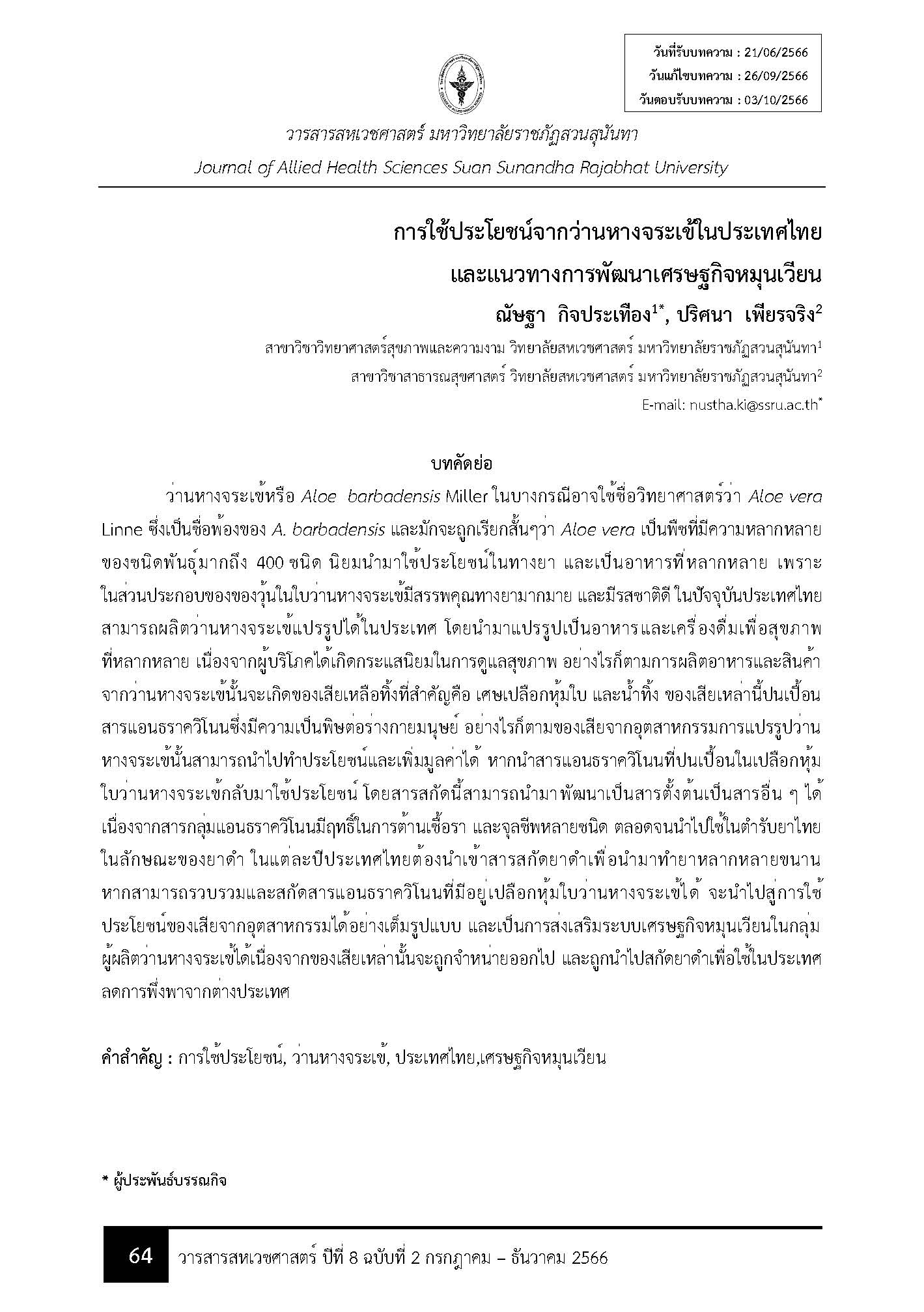การใช้ประโยชน์จากว่านหางจระเข้ในประเทศไทย และแนวทางการพัฒนาเศรษฐกิจหมุนเวียน
Main Article Content
บทคัดย่อ
ว่านหางจระเข้หรือ Aloe barbadensis Miller ในบางกรณีอาจใช้ชื่อวิทยาศาสตร์ว่า Aloe vera Linne ซึ่งเป็นชื่อพ้องของ A. barbadensis และมักจะถูกเรียกสั้นๆว่า Aloe vera เป็นพืชที่มีความหลากหลายของชนิดพันธุ์มากถึง 400 ชนิด นิยมนำมาใช้ประโยชน์ในทางยา และเป็นอาหารที่หลากหลาย เพราะ ในส่วนประกอบของของวุ้นในใบว่านหางจระเข้มีสรรพคุณทางยามากมาย และมีรสชาติดี ในปัจจุบันประเทศไทยสามารถผลิตว่านหางจระเข้แปรรูปได้ในประเทศ โดยนำมาแปรรูปเป็นอาหารและเครื่องดื่มเพื่อสุขภาพที่หลากหลาย เนื่องจากผู้บริโภคได้เกิดกระแสนิยมในการดูแลสุขภาพ อย่างไรก็ตามการผลิตอาหารและสินค้าจากว่านหางจระเข้นั้นจะเกิดของเสียเหลือทิ้งที่สำคัญคือ เศษเปลือกหุ้มใบ และน้ำทิ้ง ของเสียเหล่านี้ปนเปื้อนสารแอนธราควิโนนซึ่งมีความเป็นพิษต่อร่างกายมนุษย์ อย่างไรก็ตามของเสียจากอุตสาหกรรมการแปรรูปว่านหางจระเข้นั้นสามารถนำไปทำประโยชน์และเพิ่มมูลค่าได้ หากนำสารแอนธราควิโนนที่ปนเปื้อนในเปลือกหุ้มใบว่านหางจระเข้กลับมาใช้ประโยชน์ โดยสารสกัดนี้สามารถนำมาพัฒนาเป็นสารตั้งต้นเป็นสารอื่น ๆ ได้ เนื่องจากสารกลุ่มแอนธราควิโนนมีฤทธิ์ในการต้านเชื้อรา และจุลชีพหลายชนิด ตลอดจนนำไปใช้ในตำรับยาไทยในลักษณะของยาดำ ในแต่ละปีประเทศไทยต้องนำเข้าสารสกัดยาดำเพื่อนำมาทำยาหลากหลายขนานหากสามารถรวบรวมและสกัดสารแอนธราควิโนนที่มีอยู่เปลือกหุ้มใบว่านหางจระเข้ได้ จะนำไปสู่การใช้ประโยชน์ของเสียจากอุตสาหกรรมได้อย่างเต็มรูปแบบ และเป็นการส่งเสริมระบบเศรษฐกิจหมุนเวียนในกลุ่มผู้ผลิตว่านหางจระเข้ได้เนื่องจากของเสียเหล่านั้นจะถูกจำหน่ายออกไป และถูกนำไปสกัดยาดำเพื่อใช้ในประเทศ ลดการพึ่งพาจากต่างประเทศ
Article Details
เอกสารอ้างอิง
กระทรวงสาธารณสุข และองค์กรภาครัฐ – เอกชน. แผนแม่บทแห่งชาติว่าด้วยการพัฒนาสมุนไพรไทย ฉบับที่ 1 พ.ศ. 2560 – 2564. นนทบุรี : กรมพัฒนาการแพทย์แผนไทย และการแพทย์ทางเลือก กระทรวงสาธารณสุข ; 2559.
สิริดา อุปนันท์. ว่านหางจระเข้. [อินเทอร์เน๊ต]. 2562. [เข้าถึงเมื่อ 30/01/2566]; เข้าถึงได้จาก http://www.agriman.doae.go.th/home/news/2562/65-66.pdf.
ณัษฐา กิจประเทือง, ปริศนา เพียรจริง, รัตนา ปานเรียนแสน และนภดล เหลืองภิรมย์. การพัฒนาวิธีการสกัดยาดำ (Anthraquinone) จากเปลือกใบว่านหางจระเข้ จากอุตสาหกรรมเครื่องดื่มน้ำสุมนไพร. รายงานวิจัยฉบับสมบูรณ์ ทุนสนับสนุนการวิจัยมหาวิทยาลัยราชภัฏสวนสุนันทา ประจำปีงบประมาณ 2564. มหาวิทยาลัยราชภัฏสวนสุนันทา, กรุงเทพ ; 2564.
ปัญรสี สู่ศิริรัตน์ และ ภัทรา พลังเจริญสุข. การใช้สารสกัดหยาบจากเปลือกว่านหางจระเข้เพื่อควบคุมโรคแอนแทรคโนส และโรคขั้วผลเน่าในมะม่วงพันธุ์น้ำดอกไม้ เขตอำเภอปราณบุรี จังหวัดประจวบคีรีขันธ์. รายงานผลการวิจัยทุนอุดหนุนจากมหาวิทยาลัยธุรกิจบัณฑิตย์. มหาวิทยาลัยธุรกิจบัณฑิตย์, กรุงเทพ ; 2555.
Edwards E S, Rocha C da I , Williamson M E , and Heinrich M. Phytopharmacy : an evidence-based guide to herbal medicinal products, Wiley Blackwell. UK ; 2015.
สริน ทัดทอง. อนุกรมวิธานพืชสมุนไพร ในงานเภสัชกรรม. บริษัททริปเพิ้ล กรุ๊ป จำกัด, กรุงเทพ ; 2560.
Guo, X., and Mei, N. Aloe vera : A review of toxicity and adverse clinical effects. Journal of environ science health C environ Carcinog Ecotoxicol Rev 2016; 34(2) : 77 – 96.
กลุ่มงานสารสนเทศการเกษตร สำนักงานเกษตรและสหกรณ์จังหวัดประจวบคีรีขันธ์. ข้อมูลเพื่อการวางแผนพัฒนาการเกษตร รายสินค้าของจังกวัดประจวบคีรีขันธ์ ประจำปีงบประมาณ 2563 : ว่านหางจระเข้. สำนักงานปลัดกระทรวงเกษตรและสหกรณ์ กระทรวงเกษตรและสหกรณ์. 2563.
สำนักงานข้อมูลสมุนไพร คณะเภสัชศาสตร์มหาวิทยาลัย มหิดล. (ม.ป.ป.). ว่านหางจระเข้. สืบค้น วันที่ 1 พฤษภาคม 2566, จาก http://www.medplant. mahidol.ac.th/pubhealth/alovera.html
Martyna ZD, Dominica FT, Monica DJ, et al. Evaluation of clinical effectiveness of aloe vera- a review. J Pre-Clin Clin Res 2017;11(1) : 86-93
Josias H. Hamman. Composition and Applications of Aloe vera Leaf Gel. Molecules. 2008, 13 : 1599-1616
Das, S., Mishra, B., Gill, K., Ashraf, M. S., Singh, A.K., Sinha, M., Sharma, S., Xess, I., Dalal, K., Singh, T.P., and Dey, S. International Journal, 2011; 68 : 480-494
Goyal M and Sharmar SK. Traditional wisdom and value addition prospects of arid food of desert region of North West India. Indian journal of traditional knowledge 2009; 8(4) ; 581 – 585.
Adesuyi AO, Awosanya O A, Adaramola F B. and Omeonu AI. Nutritional and Phytochemical Screening of Aloe barbadensis. Current Research of Journal Biological Science 2012; 4(1): 4-9.
ตันติวัฒน์ พ. (2019). ว่านหางจระเข้. Journal of Health Research, 1(1), 57–60. Retrieved from https://he01.tci-thaijo.org/index.php/jhealthres/article/view/191633
Chang H-M, Lin Y-T, Hsiao P-L, SU Y-H, Tsao H-T, Wen K-C.. Determination of marked components –aloin and aloe-emodin- in Aloe vera before and after hydrolysis. Journal of food and drug analysis 2012 ; 20(3) : 646-652.
Hęś M, Dziedzic K., Gorecka D, Jędrusek-Gdiňka A, Gujska E.. Natural sources of antioxidant: A review. Plant food for human nutrition 2019; 74 : 255 – 265.
Kuma S, Yadav M, Yadav A, Rohilla P, and Yadav P. Antiplasmodial potential and quantification of aloin and aloe-emodin in Aloe vera collected from different climatic regions of India. BMC complementary and alternative medicine 2017 ; 17: 1-10.
Sadiq U, Gill H and Chandrapala J. Temperature and pH Stability of anthraquinones from native Aloe vera gel, spray-dried and freeze-dried Aloe vera powders during storage. Food 2022; 11(1613) :1-16.
Sánchez-Machado D I, López-Cervantes J, Mariscal-Domínguez M F, P Cruz-Flores P, Campas-Baypoli O N, Cantú-Soto E U, and Sanches-Silva A. An HPLC procedure for the quantification of aloin in latex and gel from Aloe barbadensis leaves. Journal of Chromatographic Science 2017; 55(3) : 251-257.
Logaranjan K, Devasena T, and Pandian K.. Quantitative detection of aloin and related compounds present in herbal products and Aloe vera plant extract using HPLC method. American journal of analytical chemistry 2013; 4 : 600-605.
Tan Z, Li F-F, and XU X-L. Extraction and purification of anthraquinones derivatives from Aloe vera L. using alcohol/salt aqueous two-phase system. Bioprocess Biosyst Eng 2013 ; 36 : 1105 – 1113.
พงศธร กองแก้ว และ ธานินทร์ รัชโพธิ์. การศึกษาสมบัติเชิงกลและเชิงกายภาพของพลาสติกเสริมแรงด้วยใยกาบกล้วยน้ำว้าและใยมะพร้าว. รายงานการวิจัย ทุนสนับสนุนจากสถาบันวิจัยและพัฒนา มหาวิทยาลัยราชภัฏมหาสารคาม ประจำปีงบประมาณ 2557. มหาวิทยาลัยราชภัฏมหาสารคาร, มหาสารคาม; 2558
Cheng, S., Panthapulakkal, S., Sain, M., Asiri, A. Aloe vera rind cellulose nano fi bers-reinforced fi lms. Journal of Applied Polymer Science, 2014, 131(15), 40592.
Jeltzlin Semerel, Nigel John, Wim Dehaen and Pedro Fardim 3. Valorization of Aloe barbadensis Miller. (Aloe vera) Processing Waste. Journal of Renewable Materials. June 2022
Ma, L. K., Chen, K., Tian, X. F., Gao, Y. H., Zhang, S. A. et al. Effect of particle size on the physicochemical property of the peel powder from Aloe barbadensis. IOP Conference Series: Earth and Environmental Science, 2020, 612(1)
Añibarro-Ortega, M., Pinela, J., Barros, L., Ć iri ć , A., Silva, S. P. et al.Compositional features and bioactive properties of Aloe vera leaf (Fillet, mucilage, and rind) and fl ower. Antioxidants, 2019, 8(10), 444.
López, A., de Tangil, M. S., Vega-Orellana, O., Ramírez, A. S., Rico, M. Phenolic constituents, antioxidant and preliminary antimycoplasmic activities of leaf skin and fl owers of Aloe vera (L.) burm. f. (syn. A. barbadensis mill.) from the canary islands (Spain). Molecules, 2013, 18(5), 4942 – 4954.
Lucini, L., Pellizzoni, M., Pellegrino, R., Molinari, G. P., Colla, G. Phytochemical constituents and in vitro radical scavenging activity of different aloe species. Food Chemistry, 2015, 170, 501 – 507.
Nalimu F, Oloro J, Kahwa I and Ogwang E P. Review on the phytochemistry and toxicological profiles of Aloe vera and Aloe ferox. Future journal of pharmaceutical sciences 2021, 7 (145), 1-21
Kumar, K.P.S., Bhowmik, D., Chiranjib, B., 2010. Aloe vera: a potential herb and its medicinal importance. Jounal Chem. Pharm. Res. 2, 21–29.
ฝ่ายสื่อสารและภาพลักษณ์องค์กร (CBC). โมเดลเศรษฐกิจใหม่ BCG. [อินเทอร์เน็ต]. 2563.สำนักงานพัฒนาวิทยาศาสตร์และเทคโนโลยีแห่งชาติ (สวทช.). เข้าถึงได้จาก : https://www.nstda.or.th/home/knowledge_post/bcg-by-nstda/

